Excerpts from Jim Conrad's
Naturalist Newsletter
Issued on March 12, 2020, from the forest just west of Tepakán; elev. ~9m (~30 ft), N21.053°, W89.052°; north-central Yucatán state, MÉXICO
PREDATORY, CARNIVOROUS BEES?
Now during the mid dry-season when organisms are stressed by heat and lack of rain, I keep a shallow pan filled with water on a platform of my outside kitchen. From dawn to dusk honeybees, predominantly, but also White-winged Wasps, and other smaller species of bees and wasps gather all along the pan's rim, drinking. One mid morning I noticed fewer honeybees than usual, and the few present seemed disturbed. On the concrete floor below the pan, a honeybee on her back was buzzing and trying to set herself upright, but something smaller than she and black was atop her, shown below:

It's hard to see details of the smaller insect atop the honeybee, except for its size, overall black color, and its pale-tipped wings. As I watched the above struggle, another honeybee plopped onto the cement floor beside me, also with one or two similar black insects clinging to her and maybe biting into her. Before long a White-winged Wasp, Parachartergus apicalis, similarly fell, also with two or more small, black insects holding on, seeming to be biting into her abdomen. Apparently the small, black insects were attacking honeybees and wasps gathered along the water-pan's rim. On the rim I saw several of the attackers, one shown below:

It looked like a bee, but I hadn't heard of bees exhibiting this kind of behavior. Surely it was a predaceous wasp species mimicking a bee. Though on the Internet I found several pictures of bee-mimicking wasps, none was as absolutely bee-like as this one. Note the sharp mandibles projecting beneath the head. Eventually I remembered that carpenter bees chew wood with well developed mandibles, so gradually I became open to the notion that this might really be a carnivorous bee species.
I watched as two or three predators work along the pan's rim, slowly approaching drinking bees. The bees seemed aware that these little black insects were dangerous. Some flew away immediately when the predators began their slow approach, others kept drinking but edged sideways away from them, and others seemed oblivious to the attackers until an attacker got close, at which instant the attacker rushed at her quarry at the same time the honeybee flew away. I never saw a successful attack. Maybe the honeybees were "figuring out" what was happening the same time I was.
On the cement floor, several attackers were clustered around a dark object, shown below:
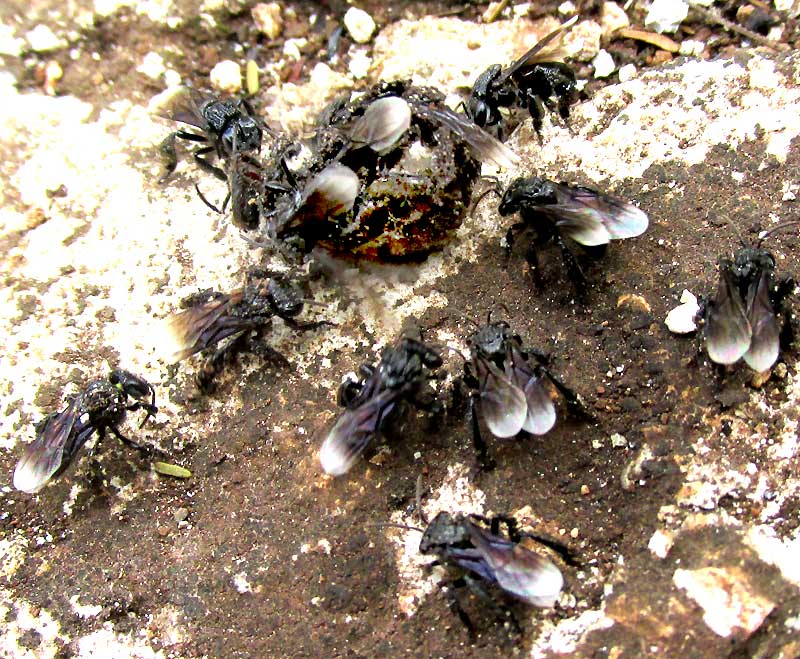
The attackers appear to be dealing with a spherical object that reflects light in a way that gives the impression that it's moist. I've seen predaceous wasps form such balls from flesh of caterpillars they'd stung and butchered, so I'm guessing that this is something similar. However, those wasp meatballs had been small enough for the wasps to carry to their nests, while this meatball -- if that's what it is -- is much too large for that. I didn't watch what they did with this meatball because when I photographed it, with my poor vision, I thought it was just another succumbing honeybee on the floor.
Probably about 20-30 of these predaceous visitors visited the bees and wasps at the water pan that morning. Within an hour they had left, and bees and wasps were back crowding the pan's rim as always. During the five days since the attack took place, I've not seen any of the predators again.
The predators seemed particularly vulnerable to drowning in the pan's water. During the attack I'd fished out several struggling at the water's surface, plus three or four were found drowned. A couple of drowned ones are shown below, for identification purposes.
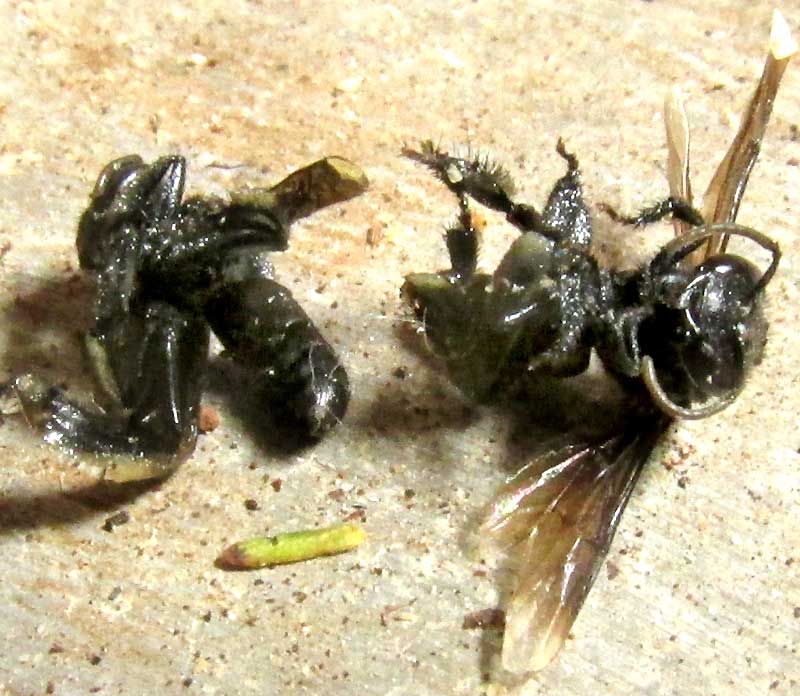
The back legs' structure is particularly interesting.
On the Internet I find nothing like it, though images of species of the genus Trigona come close. I was led to Trigona when I searched on the keywords "predaceous bees Mexico" and found a 2016 page by Michelle Ross entitled "Carnivorous Bees," featured as "A Moment of Science" on an Indiana Public Media website. Featured is Trigona hypogea, described as collecting meat from animal carcasses, as well as carrying off wasp eggs, larvae and pupae, even toad eggs. Ross writes"
"The bees prepare the meat for later consumption by the younger members of the colony by chewing it and then mixing it with sugary liquids, perhaps collected from fruit. Microbes break the mixture down into a viscous goo, which delivers important nutrients to the young bees."
I don't believe we're dealing with Trigona hypogea here, but maybe something closely related, and since I find nothing about such bee behavior as documented here, there's a good possibility we have a new species. I'm waiting for the right expert to come along, see this page, and let me know what he or she thinks.
Issued on March 16, 2020, from the forest just west of Tepakán; elev. ~9m (~30 ft), N21.053°, W89.052°; north-central Yucatán state, MÉXICO
A SECOND ATTACK
A week after the attack described above, a second attack took place at about the same time in mid morning. This time when I first noticed them maybe 60-70 attackers were buzzing around the pan of water, and honeybees were leaving their positions on the pan's rim. This time I saw that though some attackers worked along the rim, attacking from the side, most successful attachments came from landing on a rim-perched, drinking honeybee's back and, apparently, immediately biting into the body and holding on as the bee fell to the ground. Again White-winged Wasps were victimized.
On the concrete floor below the water pan I searched for "meatballs" as shown above but found none, nor were any of the several downed honeybees and wasps being butchered in a way that might lead to a meatball. The attackers just seemed to be hanging onto their prey, sometimes four or five on the same honeybee, but usually honeybees managed within a minute or two to rid themselves of all but one attacker, who normally then hang on the honeybee's undersurface as the honeybee walked around aimlessly buzzing her wings and working with her feet to dislodge the predator.
Once a predator was dislodged, seldom did the dislodged bee make an effort to reattach to the honeybee. One bee took 15 minutes to dislodge his attacker. All honeybees I watched for several minutes eventually rid themselves of their attackers, though the honeybees apparently were so wounded that at first they couldn't fly. For several minutes they'd "preen" themselves with their feet, while trying to fly, but usually, at least at first, they couldn't. When they eventually did fly off, it was very weakly and probably few or none made it back to the hive.
I wonder if the attackers are so disinterested in re-attaching to their prey because while attached they attain the protein they seek? Also I'm wondering if maybe the meatball shown above has nothing to do with the attack. Maybe a wasp carrying the meatball was attacked, dropping it near the pan?
By the time I returned to the water pan, no attackers remained buzzing around, and on the floor none were attached to a honeybee. They'd all moved away. All, except those drowned in the pan, of which there were 24, along with four or five honeybees. Honeybees when they're attacked on the rim frequently fly into the water, where apparently they extricate themselves from the water at a higher rate than the smaller predators. A small raft of dead bees is shown below:
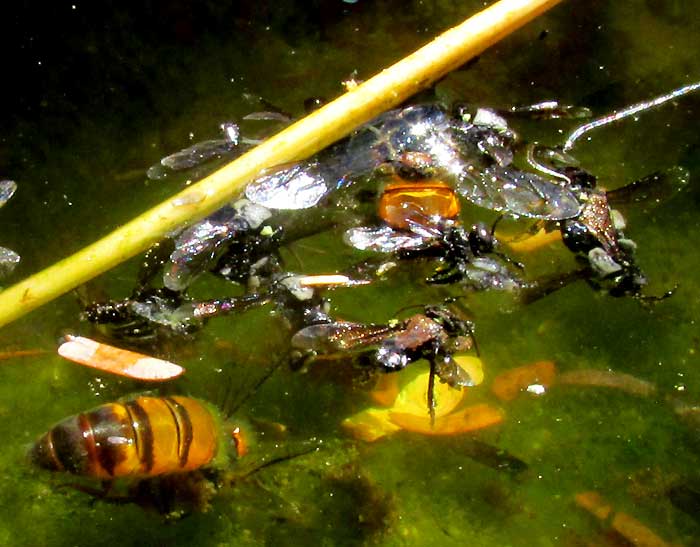
With a handlens I looked for puncture marks on the drowned honeybees but could find none.
Issued on March 23, 2020, from the forest just west of Tepakán; elev. ~9m (~30 ft), N21.053°, W89.052°; north-central Yucatán state, MÉXICO
ALMOST DAILY ATTACKS
About three weeks after the first noted attacks, the attacks have become nearly a daily occurrence. If I'm not around, the events announce themselves with drowned attacker-bees in the watering pan. The number of attackers has decreased, as has their aggressiveness. Now they seldom rush at their prey but approach more slowly, and are easily dissuaded when the prey moves away. I saw one attacker land atop a honeybee, hold on for about 30 seconds, and then become dislodged, without trying to reattach, which I'd not seen before. Attacks continue to occur only in mid morning. Honeybees seem to have learned to avoid that drinking time better than the White-winged Wasps. Below are shots of an attack on a White-winged Wasp. The first image shows an attacker seemingly with its mandibles inserted into the wasp. Both had drowned. A second drowned attacker is at the picture's top, right corner:
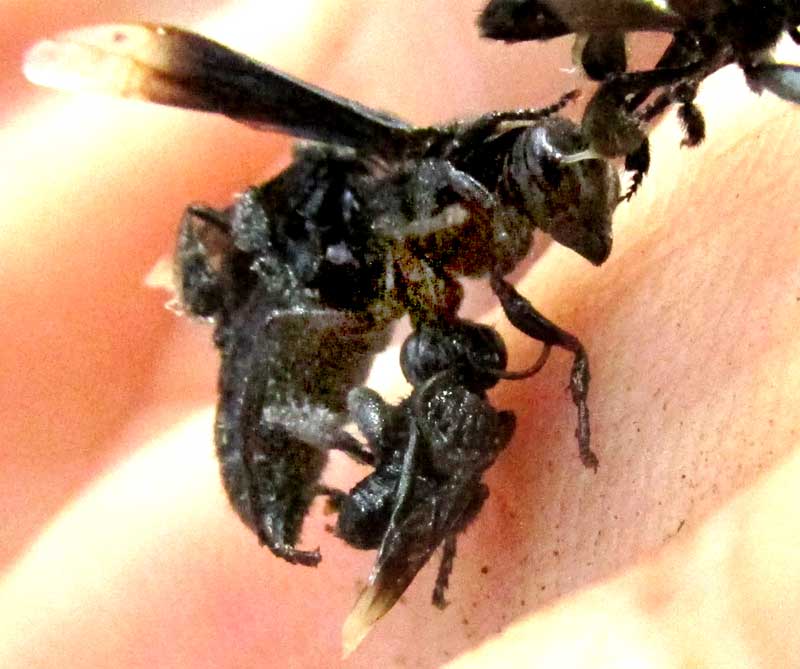
Another shot of a live, struggling wasp with a bee seeming to "bite" into the wasp's underside:
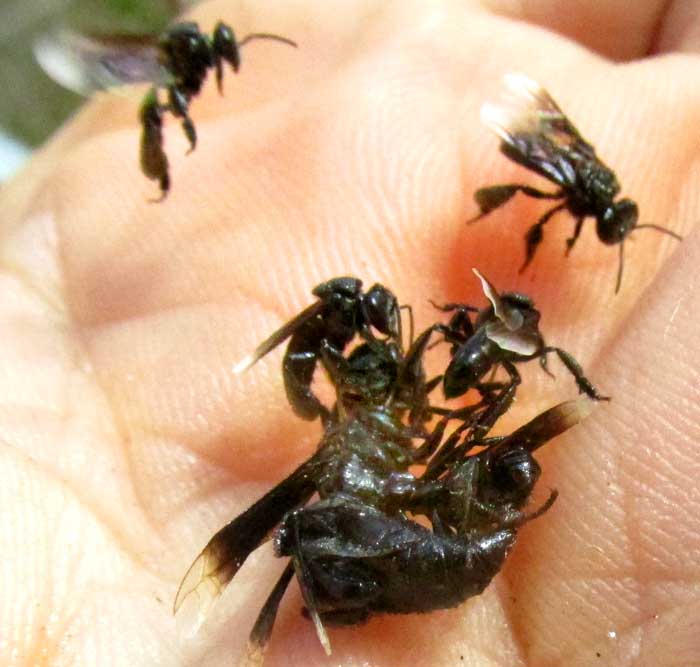
Two bees attached to a wasp:
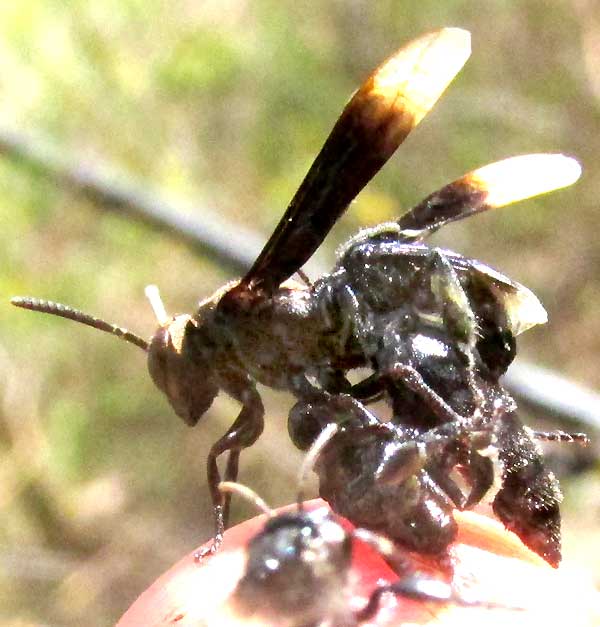
The above pictures show action in my hand. As I took those pictures, numerous attackers swarmed around my hand and my chest, though no attempt was made to "bite" me. A general view of my hand in which several bees are attacking a struggling wasp appears below:
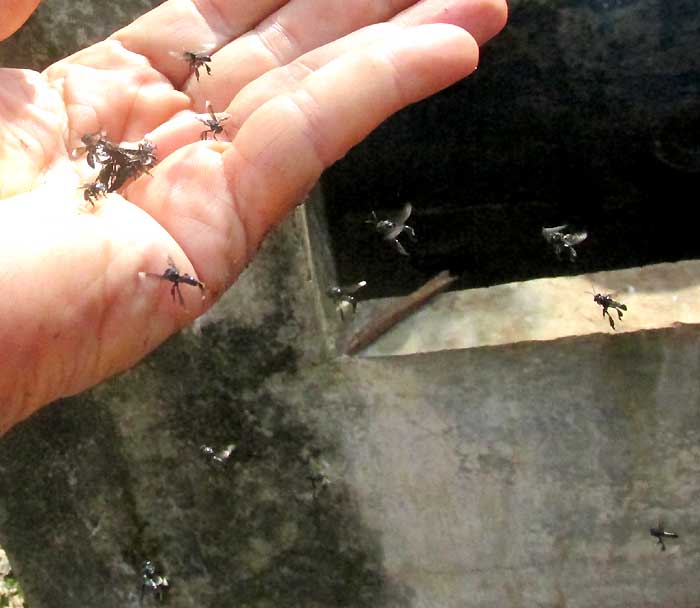
In the picture below, possibly we can see the bee's open mandibles jabbing at a struggling wasp. The white item against which the mandibles may be silhouetted is an acacia leaflet.
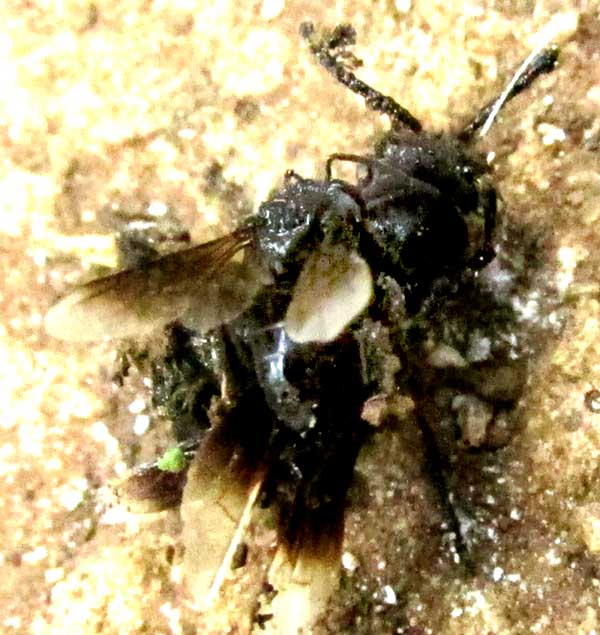
Issued on March 26, 2020, from the forest just west of Tepakán; elev. ~9m (~30 ft), N21.053°, W89.052°; north-central Yucatán state, MÉXICO
MAYBE NOT PREDATORS AT ALL...
Now the attacks have ceased, or are very limited and erratic, so that I've not seen more floating bodies in the pan. However, for the first time I've noticed that the attackers are entering and leaving holes in the stone wall on which the pan sits -- only about a foot distance from the watering pan! The original construction of the stone wall was done sloppily with cement, so there are openings between the stones and inside the wall there must be chambers.
An online follower of this discussion, Glenn, was kind enough to find someone knowing about bees, who suggested that possibly the attackers were defending a source of protein against the honeybees. Now I'm thinking that that suggestion may be right, except that maybe they're defending a nesting site, or where they want to establish one.
So, here we have lots of information we still can't put together, and we're still waiting for our expert to come along.